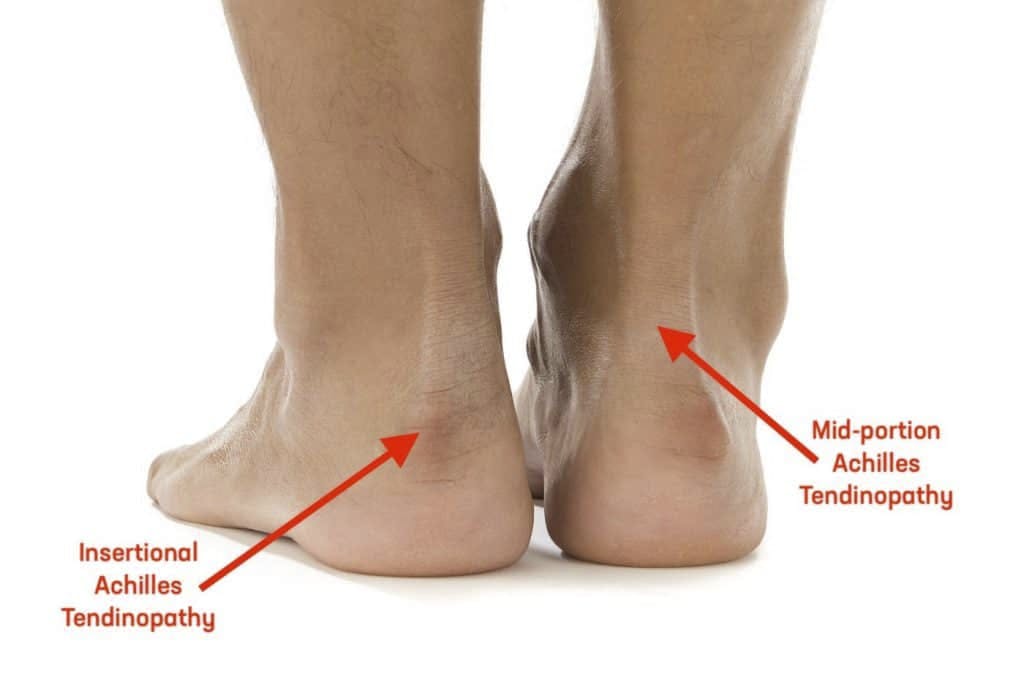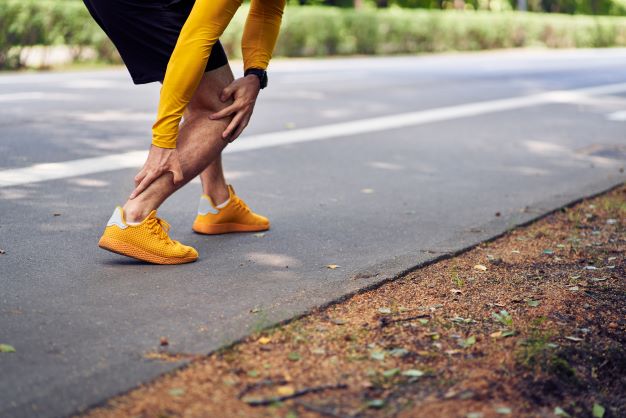Sometimes Achilles tendon pain just won’t go away. Achilles tendinitis is one of the most stubborn injuries we see in physical therapy. The problem is common in runners and many other athletes. However, Achilles tendinitis also plagues millions of less active people. Injections, shockwave therapy, surgery, and exercise are the most effective treatments. This article teaches you how to do eccentric exercise proven to help alleviate pain from Achilles tendinitis.
Insertional versus Mid-Portion Achilles Tendinitis
There are 2 types of Achilles tendinitis. These are insertional and non insertional (or midportion) tendinitis. The non insertional type is most common. It involves the middle portion of your tendon. This is usually a 1 or 2 finger-widths above your heel.

Insertional Achilles tendinitis involves the lower part of your heel. This is where your tendon attaches to your heel bone. In both non insertional and insertional Achilles tendinitis, your damaged tendon fibers may calcify (harden). This results in the appearance of a bump near your heel. The prognosis for a full and speedy recovery is worse for insertional tendinitis.
Eccentric Exercises Proven to Help Stubborn Achilles Tendinitis
A 2021 study published in the Journal of Bone and Joint Surgery looked at 119 patients with insertional Achilles tendon pain. Half of these patients did eccentric exercises and received shockwave therapy. The other group did eccentric exercises with fake shockwave therapy (placebo). Each patient received 3 sessions of shockwave therapy (or placebo) spaced out every 2 weeks. Patients did their eccentric exercises twice per day for 3 months.
Six months later both groups of patients improved. Both groups reported improved pain by about the same amount (63%). It made no difference whether patients received real or fake shockwave therapy. This suggests eccentric exercise was the primary reason for their improvement.
What is Eccentric Exercise?
Traditional strength training exercises use load during both the muscle shortening (concentric) and muscle lengthening (eccentric) phases of a movement. Eccentric exercises load a specific muscle or set of muscles and tendons while they are lengthening. With a painful Achilles tendon, this means you load or exercise your calf muscle while it is getting longer. The load is removed when you’re your calf muscle shortens.

Higher muscle and tendon forces are produced during eccentric muscle actions. Research has shown eccentric exercises improve your tendon structure at a microscopic level. This leads to greater tendon strength and stiffness. A stronger tendon will withstand high loads without triggering a pain response.
How to Do Eccentric Exercise
Start by standing on your good leg only. Use the back of a chair or the wall for balance. Slowly rise up onto your tip-toe with your good leg. Then shift all your weight onto your painful leg. Slowly lower yourself to the starting position using only your painful leg. Repeat this sequence of “up with the good” and “down with the bad” leg.
Do 3 sets of 10 to 15 repetitions twice per day. Expect some pain when you start. The first 2 weeks will be the hardest. Pain during exercise that is 5/10 or less is acceptable. If you experience anything more than this, contact your physical therapist.
As your pain improves and you get stronger, begin doing this exercise with your heels hanging from a step. Then progress things even further by adding a backpack with weight. Start with 10 pounds and work up from there.
Beat Achilles Tendinitis for Good: See Your Physical Therapist to Develop a Complete Plan
Greater improvements are made when exercise is combined with manual therapy performed by your physical therapist. One recent study showed the addition of soft tissue techniques resulted in 100% of patients achieving a successful outcome at 12 weeks compared to 50% who performed only exercise. During each physical therapy session, 15 minutes of soft tissue mobilization is applied to the lower leg, ankle, and foot. The purpose is to improve mobility and further stimulate tendon healing.
To beat Achilles tendinitis for good work with a physical therapist. Your physical therapist will fully evaluate your strength, mobility, and movement patterns. Once all contributing factors are identified, a comprehensive rehab program is developed.
Call our office to get started. The doctors of physical therapy at BSR have been helping people in Southern Ocean County move without pain since 2007. We are here to help you.

